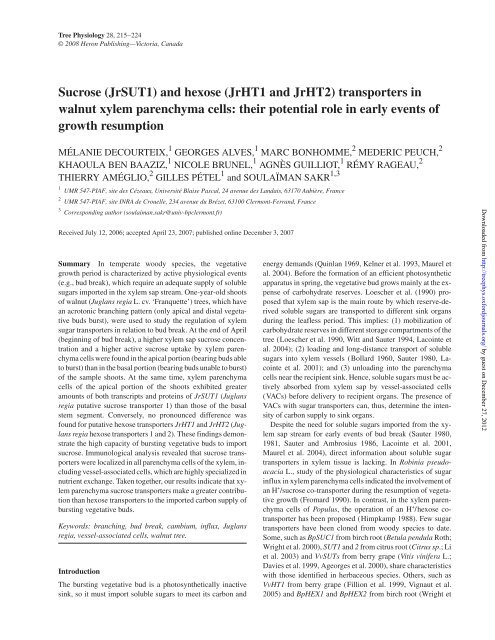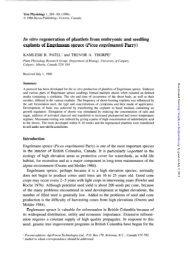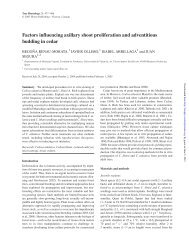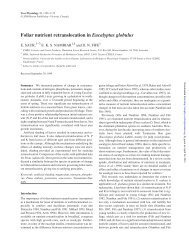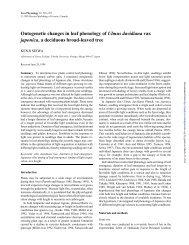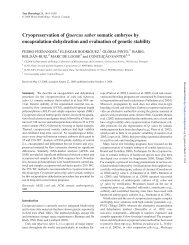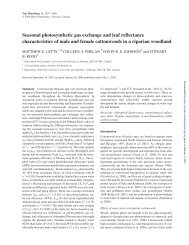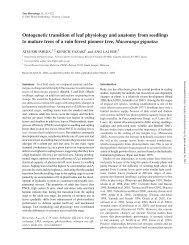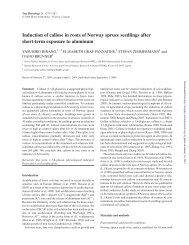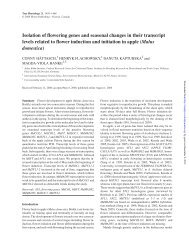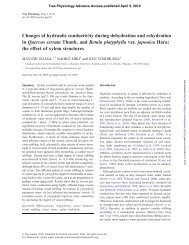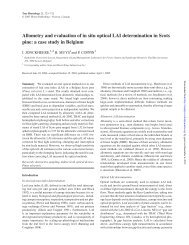Sucrose (JrSUT1) and hexose (JrHT1 and JrHT2 ... - Tree Physiology
Sucrose (JrSUT1) and hexose (JrHT1 and JrHT2 ... - Tree Physiology
Sucrose (JrSUT1) and hexose (JrHT1 and JrHT2 ... - Tree Physiology
You also want an ePaper? Increase the reach of your titles
YUMPU automatically turns print PDFs into web optimized ePapers that Google loves.
<strong>Tree</strong> <strong>Physiology</strong> 28, 215–224<br />
© 2008 Heron Publishing—Victoria, Canada<br />
<strong>Sucrose</strong> (<strong>JrSUT1</strong>) <strong>and</strong> <strong>hexose</strong> (<strong>JrHT1</strong> <strong>and</strong> <strong>JrHT2</strong>) transporters in<br />
walnut xylem parenchyma cells: their potential role in early events of<br />
growth resumption<br />
MÉLANIE DECOURTEIX, 1 GEORGES ALVES, 1 MARC BONHOMME, 2 MEDERIC PEUCH, 2<br />
KHAOULA BEN BAAZIZ, 1 NICOLE BRUNEL, 1 AGNÈS GUILLIOT, 1 RÉMY RAGEAU, 2<br />
THIERRY AMÉGLIO, 2 GILLES PÉTEL 1 <strong>and</strong> SOULAÏMAN SAKR 1,3<br />
1<br />
UMR 547-PIAF, site des Cézeaux, Université Blaise Pascal, 24 avenue des L<strong>and</strong>ais, 63170 Aubière, France<br />
2<br />
UMR 547-PIAF, site INRA de Crouelle, 234 avenue du Brézet, 63100 Clermont-Ferr<strong>and</strong>, France<br />
3 Corresponding author (soulaiman.sakr@univ-bpclermont.fr)<br />
Received July 12, 2006; accepted April 23, 2007; published online December 3, 2007<br />
Summary In temperate woody species, the vegetative<br />
growth period is characterized by active physiological events<br />
(e.g., bud break), which require an adequate supply of soluble<br />
sugars imported in the xylem sap stream. One-year-old shoots<br />
of walnut (Juglans regia L. cv. ‘Franquette’) trees, which have<br />
an acrotonic branching pattern (only apical <strong>and</strong> distal vegetative<br />
buds burst), were used to study the regulation of xylem<br />
sugar transporters in relation to bud break. At the end of April<br />
(beginning of bud break), a higher xylem sap sucrose concentration<br />
<strong>and</strong> a higher active sucrose uptake by xylem parenchyma<br />
cells were found in the apical portion (bearing buds able<br />
to burst) than in the basal portion (bearing buds unable to burst)<br />
of the sample shoots. At the same time, xylem parenchyma<br />
cells of the apical portion of the shoots exhibited greater<br />
amounts of both transcripts <strong>and</strong> proteins of <strong>JrSUT1</strong> (Juglans<br />
regia putative sucrose transporter 1) than those of the basal<br />
stem segment. Conversely, no pronounced difference was<br />
found for putative <strong>hexose</strong> transporters <strong>JrHT1</strong> <strong>and</strong> <strong>JrHT2</strong> (Juglans<br />
regia <strong>hexose</strong> transporters 1 <strong>and</strong> 2). These findings demonstrate<br />
the high capacity of bursting vegetative buds to import<br />
sucrose. Immunological analysis revealed that sucrose transporters<br />
were localized in all parenchyma cells of the xylem, including<br />
vessel-associated cells, which are highly specialized in<br />
nutrient exchange. Taken together, our results indicate that xylem<br />
parenchyma sucrose transporters make a greater contribution<br />
than <strong>hexose</strong> transporters to the imported carbon supply of<br />
bursting vegetative buds.<br />
Keywords: branching, bud break, cambium, influx, Juglans<br />
regia, vessel-associated cells, walnut tree.<br />
Introduction<br />
The bursting vegetative bud is a photosynthetically inactive<br />
sink, so it must import soluble sugars to meet its carbon <strong>and</strong><br />
energy dem<strong>and</strong>s (Quinlan 1969, Kelner et al. 1993, Maurel et<br />
al. 2004). Before the formation of an efficient photosynthetic<br />
apparatus in spring, the vegetative bud grows mainly at the expense<br />
of carbohydrate reserves. Loescher et al. (1990) proposed<br />
that xylem sap is the main route by which reserve-derived<br />
soluble sugars are transported to different sink organs<br />
during the leafless period. This implies: (1) mobilization of<br />
carbohydrate reserves in different storage compartments of the<br />
tree (Loescher et al. 1990, Witt <strong>and</strong> Sauter 1994, Lacointe et<br />
al. 2004); (2) loading <strong>and</strong> long-distance transport of soluble<br />
sugars into xylem vessels (Bollard 1960, Sauter 1980, Lacointe<br />
et al. 2001); <strong>and</strong> (3) unloading into the parenchyma<br />
cells near the recipient sink. Hence, soluble sugars must be actively<br />
absorbed from xylem sap by vessel-associated cells<br />
(VACs) before delivery to recipient organs. The presence of<br />
VACs with sugar transporters can, thus, determine the intensity<br />
of carbon supply to sink organs.<br />
Despite the need for soluble sugars imported from the xylem<br />
sap stream for early events of bud break (Sauter 1980,<br />
1981, Sauter <strong>and</strong> Ambrosius 1986, Lacointe et al. 2001,<br />
Maurel et al. 2004), direct information about soluble sugar<br />
transporters in xylem tissue is lacking. In Robinia pseudoacacia<br />
L., study of the physiological characteristics of sugar<br />
influx in xylem parenchyma cells indicated the involvement of<br />
an H + /sucrose co-transporter during the resumption of vegetative<br />
growth (Fromard 1990). In contrast, in the xylem parenchyma<br />
cells of Populus, the operation of an H + /<strong>hexose</strong> cotransporter<br />
has been proposed (Himpkamp 1988). Few sugar<br />
transporters have been cloned from woody species to date.<br />
Some, such as BpSUC1 from birch root (Betula pendula Roth;<br />
Wright et al. 2000), SUT1 <strong>and</strong> 2 from citrus root (Citrus sp.; Li<br />
et al. 2003) <strong>and</strong> VvSUTs from berry grape (Vitis vinifera L.;<br />
Davies et al. 1999, Ageorges et al. 2000), share characteristics<br />
with those identified in herbaceous species. Others, such as<br />
VvHT1 from berry grape (Fillion et al. 1999, Vignaut et al.<br />
2005) <strong>and</strong> BpHEX1 <strong>and</strong> BpHEX2 from birch root (Wright et<br />
Downloaded from<br />
http://treephys.oxfordjournals.org/ by guest on December 27, 2012
216 DECOURTEIX ET AL.<br />
al. 2000), are highly homologous with the already isolated<br />
<strong>hexose</strong> transporters.<br />
To date, the only sugar co-transporter gene identified from<br />
xylem tissue of a woody species is the Juglans regia L. putative<br />
sucrose transporter (<strong>JrSUT1</strong>), which encodes a putative<br />
stem-specific sucrose transporter (Decourteix et al. 2006). Its<br />
role has been investigated only in the autumn–winter period,<br />
when it appears to mediate the influx of sucrose released into<br />
the xylem sap after freeze/thaw events (Decourteix et al.<br />
2006). Although the physiological significance of some sugar<br />
transporters has been investigated, their involvement in vegetative<br />
bud burst has not been studied. However, because the<br />
plasma membrane H + -ATPase (PM-H + -ATPase) energizes a<br />
large set of secondary transporters, such as sugar transporters,<br />
studies have focused mainly on this protein (Fromard et al.<br />
1995, Arend et al. 2002, 2004, Alves et al. 2004). Plasma<br />
membrane H + -ATPase is reported to be seasonally regulated in<br />
walnut xylem tissue, because its amount <strong>and</strong> activity are<br />
higher when bud break occurs at the end of April, than in February<br />
(Alves et al. 2004, 2007). These findings support the<br />
idea that PM-H + -ATPase contributes to the early events of bud<br />
break by permitting sugar uptake from xylem sap, presumably<br />
via H + /sugar co-transporters.<br />
Our study focused on the characterization of putative sugar<br />
transporters in xylem tissues during the first stages of the<br />
growing season, with particular attention to the early events of<br />
bud break. Walnut (J. regia) cv. ‘Franquette’ was chosen as the<br />
study species because it exhibits an acrotonic branching pattern<br />
(the apical part of the shoot bears buds that are able to<br />
grow, whereas the basal part of the shoot bears buds that do not<br />
normally grow). Because sucrose <strong>and</strong> <strong>hexose</strong>s (glucose <strong>and</strong><br />
fructose) comprise 95% of the total soluble sugars in walnut<br />
xylem sap during bud break (Alves 2003), the possible involvement<br />
of their respective transporters was investigated<br />
based on their patterns of activity <strong>and</strong> accumulation during the<br />
study period.<br />
Materials <strong>and</strong> methods<br />
Plant material<br />
Thirteen-year-old walnut trees (J. regia) cv. ‘Franquette’<br />
grown in an INRA orchard near Clermont-Ferr<strong>and</strong> (south-central<br />
France, 45° N, 3° E) were selected for study. One-year-old<br />
shoots were collected at the end of each month, from March<br />
(early spring) to June (acquisition of autotrophy for carbon by<br />
new shoots). Segments were sampled 10 cm below the apical<br />
vegetative bud (apical stem segment) <strong>and</strong> 10 cm above the<br />
lowermost portion of the shoot (basal stem segment), <strong>and</strong> the<br />
xylem tissue collected as described by Alves et al. (2007).<br />
Starch <strong>and</strong> soluble sugar in xylem parenchyma cells<br />
Soluble sugars were extracted from the xylem tissue with<br />
80:20 (v/v) hot (80 °C) ethanol:water <strong>and</strong> purified as described<br />
by Moing <strong>and</strong> Gaudillière (1992). Glucose, fructose<br />
<strong>and</strong> sucrose concentrations were determined spectrophotometrically<br />
at 340 nm after enzymatic assays (Boehringer<br />
TREE PHYSIOLOGY VOLUME 28, 2008<br />
1984). Starch concentration was determined by a hexokinasecatalyzed<br />
glucose-6-phosphate linked assay (Kunst et al.<br />
1984) after hydrolysis of the sample with amyloglucosidase<br />
(Boehringer 1984).<br />
Xylem sap sugar concentration<br />
Immediately after stem excision, xylem sap was collected separately<br />
from the apical <strong>and</strong> basal portions of the excised shoots<br />
by vacuum extraction, according to the method of Bollard<br />
(1953). To avoid contamination of extracted xylem sap by<br />
phloem sap, the bark was scraped to a distance of about 3 cm<br />
from each end of the shoots. Following extraction, the xylem<br />
sap was heated to 80 °C for 20 min, <strong>and</strong> its sugar content determined<br />
as described by Maurel et al. (2004).<br />
Uptake of sucrose <strong>and</strong> glucose by xylem parenchyma cells<br />
Twenty-cm-long segments were cut from the apical <strong>and</strong> basal<br />
ends of 1-year-old stems preconditioned at 15 °C for 48 h in a<br />
temperature-controlled chamber (Liebherr 650l). Tissues outside<br />
the cambium were scraped from the ends of the segments<br />
to prevent phloem constituents entering the xylem at the ends<br />
of the stem segments. Each segment was perfused with 3 ml of<br />
the control solution (0.1 mM MgCl2, 0.1 mM KCl, 0.1 mM<br />
CaCl2 <strong>and</strong> 10 mM MES adjusted to pH 5.5 with HCl) under<br />
moderate pressure (0.1 MPa), <strong>and</strong> then perfused with 2 ml of a<br />
radioactive solution (control solution supplemented with<br />
1mM 14 C-labeled sucrose (70 kBeq ml –1 ) or with 1 mM<br />
14 –1<br />
C-labeled glucose (70 kBeq ml ) (both from NEN Life Science)<br />
in the presence <strong>and</strong> absence of 1 mM HgCl2 to dissipate<br />
the electrochemical potential difference. After a 1-h incubation<br />
at 15 °C, xylem vessels were rinsed with 6 ml of control<br />
solution <strong>and</strong> the shoot segments immediately frozen <strong>and</strong><br />
stored at –20 °C until lyophilized, ground <strong>and</strong> the sugar extracted<br />
<strong>and</strong> radioactivity determined.<br />
Soluble sugar flux from xylem to vegetative buds<br />
During vegetative bud break (April), total fluxes of soluble<br />
sugars from xylem vessels to buds were determined by a<br />
method based on that of Valentin et al. (2001). Five-cm-long<br />
segments were cut from the apical <strong>and</strong> basal ends of 1-year-old<br />
shoots preconditioned at 15 °C for 48 h. Each segment was<br />
perfused first with 3 ml of control solution (1 mM KCl <strong>and</strong><br />
NaCl <strong>and</strong> 0.2 mM CaCl2 adjusted to pH 6 with HCl) under<br />
moderate pressure (0.1 MPa) of nitrogen gas, <strong>and</strong> then with<br />
0.5 ml of a radioactive-sugar solution (control solution supplemented<br />
with 10 mM 14 C-labeled sucrose (70 kBeq ml –1 ), or<br />
10 mM 14 C-labeled glucose (70 kBeq ml –1 ), or 200 mM 3 H-labeled<br />
mannitol (400 kBeq ml –1 ) (Sigma). Because a mannitol<br />
transporter has not been described in walnut, <strong>and</strong> mannitol has<br />
never been found in the xylem sap of this species, mannitol<br />
was assumed to be a non-permeating osmoticum.<br />
A mannitol concentration of 200 mM was chosen to match<br />
the osmolarity of walnut xylem sap. After a 30-min incubation<br />
at 15 °C, xylem vessels were perfused (0.1 MPa) with 3 ml of<br />
unlabeled-sugar solution (10 mM sucrose or 10 mM glucose,<br />
200 mM mannitol). After 8 h, the solution was expelled from<br />
Downloaded from<br />
http://treephys.oxfordjournals.org/ by guest on December 27, 2012
SUCROSE AND HEXOSE TRANSPORTERS IN WALNUT XYLEM PARENCHYMA 217<br />
the perfused vessels with nitrogen gas. The solution was collected<br />
for measurement of 14 C/ 3 H ratio at equilibrium <strong>and</strong> the<br />
bud immediately frozen in liquid nitrogen <strong>and</strong> stored at –20 °C<br />
until lyophilized, ground <strong>and</strong> the sugar extracted <strong>and</strong> its radioactivity<br />
determined.<br />
The sugar content of cells of vegetative buds was obtained<br />
by correcting the total 14 C radioactivity in the bud by the<br />
apoplasmic 14 C radioactivity ( 14 C cells = total 14 C– 14 C apoplasm,<br />
where 14 C apoplasm = ( 14 C/ 3 H)( 3 H in vegetative bud)).<br />
Total RNA extraction, <strong>and</strong> construction <strong>and</strong> screening of a<br />
xylem-derived cDNA library<br />
Total RNA was extracted from xylem, bark, source leaf, fine<br />
root <strong>and</strong> flowers (male <strong>and</strong> female) as described by Gévaudant<br />
et al. (1999). The RNA was quantified spectrophotometrically<br />
<strong>and</strong> its quality assessed by gel electrophoresis.<br />
A xylem <strong>hexose</strong> transporter probe was obtained by reverse<br />
transcription polymerase chain reaction (RT-PCR). Reverse<br />
transcription was carried out with 1 µg of total RNA extracted<br />
from xylem tissue in May <strong>and</strong> the Ready To Go T-primed<br />
First-Str<strong>and</strong> kit (Amersham). For the PCR, the following degenerate<br />
primers were used: Hex1, 5′-G(C/T)(T/G/C)AT-<br />
(T/C)ATGTT(C/T)TA(C/T)GC(A/C/G)CCTGT-3′; <strong>and</strong><br />
Hex2, 5′-CCA(T/A)ACTT(C/G)A(T/A)(A/C/G)CT(G/C)-<br />
(A/C)CA(C/A)(C/A)AGCAT-3′; which were deduced from<br />
conserved regions of plant <strong>hexose</strong> transporter cDNAs (EMBL<br />
data library).<br />
Amplification was carried out in a thermal cycler (Gene<br />
Amp PCR system, Perkin Elmer) according to st<strong>and</strong>ard protocols.<br />
The amplified fragment (460 bp) was sequenced <strong>and</strong><br />
used as a <strong>hexose</strong> transporter homologous probe to screen a xylem<br />
cDNA library (Sakr et al. 2003) under low stringency conditions.<br />
Two clones were obtained, completely sequenced <strong>and</strong><br />
named <strong>JrHT1</strong> <strong>and</strong> <strong>JrHT2</strong> for Juglans regia <strong>hexose</strong> transporter<br />
1 <strong>and</strong> 2, respectively. The sequences of <strong>JrHT1</strong> <strong>and</strong> <strong>JrHT2</strong> have<br />
EMBL/Genbank/DDBJ Accession nos. DQ026508 <strong>and</strong><br />
DQ026509, respectively.<br />
Semi-quantitative RT-PCR<br />
One µg of total RNA, extracted from xylem tissues as described<br />
above, was reverse transcribed. Three µl of the synthesized<br />
first-str<strong>and</strong> cDNA was amplified by PCR. Amplification<br />
of <strong>JrHT1</strong> <strong>and</strong> <strong>JrHT2</strong>, <strong>JrSUT1</strong> <strong>and</strong> JrAct (J. regia actin) was<br />
performed with the following specific primers: Hex11 (sense),<br />
5′-AGGAGATGAACAGAGTATGGAAGACC-3′ <strong>and</strong> Hex12<br />
(antisense), 5′-AGGHAAAACTAAAGAGCAAGGTCCC-3′<br />
for the amplification of <strong>JrHT1</strong> <strong>and</strong> <strong>JrHT2</strong>; Sut11 (sense),<br />
5′-AGATGCAATATCCGCAGTTCCC-3′ <strong>and</strong> Sut12 (antisense),<br />
5′-GCATGGHCTTTTGTAGCATTGGG-3′, for the<br />
amplification of <strong>JrSUT1</strong>; Act11 (sense), 5′-GATGAAGCCC-<br />
AATCAAAGAGGGGT-3′ <strong>and</strong> Act12 (antisense) <strong>and</strong> 5′-TGT-<br />
CCATCACCAGAAATCCAGCAC-3′ for the amplification of<br />
JrAct; JrEF1A (sense), 5′-TGG(A/T/C)GG(A/T)ATTGA-<br />
(T/C)AAGCGTG-3′ <strong>and</strong> JrEF1B (antisense), 5′-CAAT-<br />
(T/C)TTGTA(A/G)ACATCCTGAAG-3′ for the amplification<br />
of JrEF1 (J. regia Elongation Factor 1 alpha). Each PCR<br />
TREE PHYSIOLOGY ONLINE at http://heronpublishing.com<br />
was carried out as follows: 2 min at 94 °C for denaturation,<br />
20 s at 94 °C, 20 s at 59 °C <strong>and</strong> 45 s at 72 °C for 35 (<strong>JrHT1</strong>,<br />
<strong>JrHT2</strong> <strong>and</strong> <strong>JrSUT1</strong>), <strong>and</strong> 25 cycles (JrAct) followed by 10 min<br />
at 72 °C for the final extension. The amplification of JrEF1<br />
was carried out as follows: 2 min at 94 °C for denaturation,<br />
20 s at 94 °C, 30 s at 57 °C <strong>and</strong> 45 s at 72 °C, for 35 cycles. The<br />
optimal numbers of PCR cycles were established to generate<br />
unsaturated (linear phase) but detectable signals. All PCRs<br />
were performed in parallel on the same cDNA under the same<br />
conditions.<br />
Preparation of the affinity-purified anti-JrHTs antibody<br />
Anti-<strong>JrHT1</strong> <strong>and</strong> anti-<strong>JrHT2</strong> antiserum was raised in rabbits<br />
(Eurogentec, Herstal, Belgium) against a synthetic peptide<br />
(PKVEMGKGGRAIKNV) coupled to a carrier protein<br />
(KLH). This sequence was derived from the C-terminal region<br />
of <strong>JrHT1</strong> <strong>and</strong> <strong>JrHT2</strong>, but is not conserved in all <strong>hexose</strong> transporters<br />
from other species. Antibodies were affinity-purified<br />
against the synthetic peptide <strong>and</strong> checked for cross-reaction<br />
against the C-terminal region of <strong>JrHT1</strong>. The proteins cross-reacting<br />
with anti-<strong>JrHT1</strong> <strong>and</strong> anti-<strong>JrHT2</strong> antibodies are called<br />
<strong>JrHT1</strong> <strong>and</strong> <strong>JrHT2</strong>.<br />
The affinity-purified anti-<strong>JrSUT1</strong> antibody was raised<br />
against a synthetic peptide (MEVESANKDMRAAQR) chosen<br />
from the N-terminal region of <strong>JrSUT1</strong> (Decourteix et al.<br />
2006). As in Decourteix et al. (2006), the proteins cross-reacting<br />
with anti-<strong>JrSUT1</strong> antibody are called <strong>JrSUT1</strong>.<br />
Microsomal fraction <strong>and</strong> analysis by SDS-PAGE <strong>and</strong><br />
Western blot<br />
Xylem microsomal fractions from the apical <strong>and</strong> basal segments<br />
of the sample shoots were isolated as described by<br />
Alves et al. (2004). Protein samples (30 µg) were subjected to<br />
sodium dodecyl sulfate polyacrylamide gel electrophoresis<br />
(SDS-PAGE) according to Laemmli (1970). The gel system<br />
consisted of a 5% stacking gel <strong>and</strong> a 10% resolving gel. After<br />
electrophoresis, polypeptides were transferred to a nitrocellulose<br />
membrane (Transfer Membrane, BioTrace NT) by<br />
electroblotting. Membranes were probed with either anti-<br />
<strong>JrHT1</strong> <strong>and</strong> anti-<strong>JrHT2</strong> (1/500 dilution) or anti-<strong>JrSUT1</strong><br />
(1/3000 dilution) primary antibodies <strong>and</strong> anti-rabbit IgG<br />
(H + L) (P.A.R.I.S., Compiègne, France) peroxidase-labeled<br />
secondary antibody (1/10,000 dilution). The protein–antibody<br />
complex was detected with the ECL Western blotting<br />
analysis system (Amersham Pharmacia Biotech).<br />
<strong>JrSUT1</strong>, <strong>JrHT1</strong> <strong>and</strong> <strong>JrHT2</strong> immunolocalization in xylem<br />
parenchyma cells<br />
Immunolocalization of <strong>JrSUT1</strong> <strong>and</strong> <strong>JrHT1</strong> <strong>and</strong> <strong>JrHT2</strong> was<br />
performed on apical <strong>and</strong> basal segments of 1-year old stems as<br />
described by Decourteix et al. (2006). Briefly, each stem segment<br />
of about 4 mm in length was fixed for 45 min at 4 °C in<br />
1.5% (v/v) formaldehyde <strong>and</strong> 0.5% (v/v) glutaraldehyde in<br />
0.1 M phosphate buffer (pH 7.4) containing 0.5 % (v/v) dimethylsulfoxide<br />
<strong>and</strong> then washed in 0.1 M phosphate buffer<br />
(pH 7.4) followed by phosphate buffered saline (PBS, pH 7.2).<br />
Downloaded from<br />
http://treephys.oxfordjournals.org/ by guest on December 27, 2012
218 DECOURTEIX ET AL.<br />
Fifteen-µm sections were rinsed in PBS (pH 7.2) <strong>and</strong> bathed<br />
for 15 min in PBS containing 0.1% (v/v) Triton X-100 <strong>and</strong><br />
0.2% (w/v) glycine (pH 7.2). After saturation of nonspecific<br />
sites, sections were incubated overnight with either 1/100 diluted<br />
antibody against <strong>JrSUT1</strong>, 1/5 diluted antibody against<br />
<strong>JrHT1</strong> <strong>and</strong> <strong>JrHT2</strong> or the same antibodies saturated with the<br />
KLH-coupled synthetic peptide. After washing, sections were<br />
incubated for 3 h with goat anti-rabbit antibodies conjugated<br />
to alkaline phosphatase (Sigma) diluted in blocking solution.<br />
Tissue sections were washed with Tris buffered saline <strong>and</strong> incubated<br />
with the chromogenic substrates nitro-blue tetrazolium<br />
chloride <strong>and</strong> 5-bromo-4-chloro-3′-indolyphosphate p-toluidine<br />
salt (BioRad). Color development was carried out at<br />
room temperature <strong>and</strong> was stopped by washing in H2O.<br />
Statistical analysis<br />
Means <strong>and</strong> st<strong>and</strong>ard errors were calculated from replicates.<br />
Date <strong>and</strong> sugar effects were evaluated by analysis of variance<br />
(ANOVA) <strong>and</strong> by rank <strong>and</strong> Duncan tests (at 5%).<br />
Results<br />
Starch <strong>and</strong> sugar in xylem parenchyma cells<br />
From March to May, mean starch concentration was 1.8- to<br />
2.5-fold higher in apical stem segments than in basal stem segments<br />
of 1-year-old shoots, but there was no difference in June<br />
(Figure 1). The seasonal pattern in starch concentration was<br />
similar in the apical <strong>and</strong> basal stem segments. Starch concentration<br />
increased by a factor of two in early spring (March–<br />
April), reached a maximum in April <strong>and</strong> decreased to a minimum<br />
in June. Starch concentration was around ten- <strong>and</strong> fourfold<br />
higher in April than in June, in the apical <strong>and</strong> basal stem<br />
segments, respectively. Except in June, starch concentrations<br />
were higher than soluble sugar concentrations. In March <strong>and</strong><br />
April, mean soluble sugar concentration in xylem parenchyma<br />
cells was at a maximum, <strong>and</strong> was 1.7-fold higher in apical stem<br />
segments than in basal stem segments (Figure 1).<br />
Xylem sap sugar concentrations <strong>and</strong> uptake at bud break<br />
Mean total concentrations of sucrose <strong>and</strong> <strong>hexose</strong> in the xylem<br />
sap were 2.5-fold higher in apical stem segments than in basal<br />
stem segments of the 1-year-old shoots (2.3 versus 0.9 mg<br />
ml –1 , respectively; P < 0.05) (Figure 2A). Mean sucrose concentration<br />
was about 4-fold higher in apical stem segments<br />
than in basal stem segments, whereas <strong>hexose</strong> concentrations<br />
were similar in both (Figure 2A).<br />
Active sucrose uptake was estimated at +15 °C by subtracting<br />
passive sugar uptake (in the presence of HgCl2 ) from total<br />
sugar uptake (in the absence of HgCl2 ). At the start of bud<br />
break, mean active sucrose uptake in apical stem segments was<br />
4.3-fold higher than in basal stem segments (9.5 versus<br />
2.2 nmol g DM –1 h –1 ; P < 0.001) (Figure 2B). In contrast to sucrose,<br />
there was little active glucose uptake under the same experimental<br />
conditions.<br />
TREE PHYSIOLOGY VOLUME 28, 2008<br />
Figure 1. Changes in starch <strong>and</strong> soluble sugar (GFS = glucose + fructose<br />
+ sucrose) concentrations in xylem parenchyma cells of the apical<br />
<strong>and</strong> basal segments of 1-year-old walnut shoots. Values are means<br />
± SE of at least three replicates.<br />
<strong>JrHT1</strong> <strong>and</strong> <strong>JrHT2</strong>: putative <strong>hexose</strong> transporters<br />
To obtain putative <strong>hexose</strong> transporter cDNA from xylem tissue,<br />
conserved domains of known <strong>hexose</strong> transporter sequences<br />
from different species were used to design degenerate<br />
primers for RT-PCR. An amplified cDNA fragment of about<br />
460 bp was sequenced <strong>and</strong> found to be homologous to <strong>hexose</strong><br />
Figure 2. (A) Xylem sap sucrose (filled bars) <strong>and</strong> <strong>hexose</strong> (glucose +<br />
fructose; open bars) concentrations in apical <strong>and</strong> basal segments of<br />
1-year-old walnut shoots at the end of April (onset of bud break). Values<br />
are means ± SE of five replicates. (B) Active sucrose uptake by<br />
parenchyma cells in the apical <strong>and</strong> basal segments of 1-year-old walnut<br />
shoots estimated by subtracting passive uptake (in the presence of<br />
HgCl2 ) from total uptake (in the absence of HgCl2 ) of sucrose. Values<br />
are means + SE of at least three replicates.<br />
Downloaded from<br />
http://treephys.oxfordjournals.org/ by guest on December 27, 2012
SUCROSE AND HEXOSE TRANSPORTERS IN WALNUT XYLEM PARENCHYMA 219<br />
transporters from other species. Thus, it has been used as a homologous<br />
probe to screen a xylem-tissue-derived cDNA library<br />
(Sakr et al. 2003). Two full-length cDNA clones encoding<br />
putative <strong>hexose</strong> transporters, <strong>JrHT1</strong> <strong>and</strong> <strong>JrHT2</strong>, were isolated.<br />
The complete nucleotide sequences of the clones <strong>JrHT1</strong><br />
<strong>and</strong> <strong>JrHT2</strong> contained an open reading frame of 1563 <strong>and</strong> 1524<br />
bp, respectively, <strong>and</strong> had 98% sequence similarity. <strong>JrHT1</strong> <strong>and</strong><br />
<strong>JrHT2</strong> encode 521 <strong>and</strong> 508 amino acid polypeptides, respectively.<br />
The putative amino acid sequence of <strong>JrHT1</strong> was aligned<br />
with the deduced protein sequences of known <strong>hexose</strong> transporters<br />
(Figure 3A). The identity between <strong>JrHT1</strong> <strong>and</strong> other<br />
<strong>hexose</strong> transporters ranges from 51 to 85%, <strong>and</strong> the closest<br />
identity was found with the RcSCP from Ricinus communis L.<br />
(Weig et al. 1994).<br />
Expression analysis of these putative <strong>hexose</strong> transporters in<br />
different organs was carried out by a semi-quantitative RT-<br />
PCR approach, with RNAs extracted from leaf, fine root, xylem,<br />
bark <strong>and</strong> flowers (male <strong>and</strong> female). Because the primer<br />
pair (Hex11/Hex12) is common to <strong>JrHT1</strong> <strong>and</strong> <strong>JrHT2</strong>, the amplified<br />
b<strong>and</strong> was named <strong>JrHT1</strong> <strong>and</strong> <strong>JrHT2</strong>. <strong>JrHT1</strong> <strong>and</strong> <strong>JrHT2</strong><br />
transcripts were detected in all of the tested organs, including<br />
the xylem tissue (Figure 3B), contrasting with the sink-specific<br />
expression of a cDNA encoding a putative sucrose transporter<br />
isolated by Decourteix et al. (2006) from walnut xylem<br />
tissue (JrSUTs; Figure 3B). No significant difference in transcript<br />
abundance of <strong>JrHT1</strong> <strong>and</strong> <strong>JrHT2</strong> was found between<br />
source leaf <strong>and</strong> sink organs (xylem, fine root <strong>and</strong> bark). The<br />
lowest abundance of <strong>JrHT1</strong> <strong>and</strong> <strong>JrHT2</strong> was in male flowers.<br />
Transcript patterns of <strong>JrSUT1</strong> <strong>and</strong> <strong>JrHT1</strong> <strong>and</strong> <strong>JrHT2</strong> during<br />
the growing season<br />
The relative transcript abundance of <strong>JrHT1</strong> <strong>and</strong> <strong>JrHT2</strong> <strong>and</strong> a<br />
putative sucrose transporter <strong>JrSUT1</strong> previously isolated from<br />
walnut xylem tissue by Decourteix et al. (2006) was examined<br />
by semi-quantitative RT-PCR as previously applied to walnut<br />
xylem tissue (Sakr et al. 2003, Decourteix et al. 2006). As<br />
shown in Figure 4A, the apical <strong>and</strong> basal stem segments exhibited<br />
a contrasting pattern of <strong>JrSUT1</strong> transcript abundance. In<br />
the apical segment, <strong>JrSUT1</strong> transcripts were abundant in<br />
March <strong>and</strong> April, whereas they were undetected in May <strong>and</strong><br />
June. In the basal segment, the transcript level of <strong>JrSUT1</strong> was<br />
high in April <strong>and</strong> June <strong>and</strong> low in March <strong>and</strong> May.<br />
The pattern of <strong>JrHT1</strong> <strong>and</strong> <strong>JrHT2</strong> transcripts differed from<br />
that of <strong>JrSUT1</strong> <strong>and</strong> between the apical <strong>and</strong> basal stem segments<br />
(Figure 4B). In the apical segment, <strong>JrHT1</strong> <strong>and</strong> <strong>JrHT2</strong><br />
transcripts were slightly more abundant in April <strong>and</strong> May than<br />
in March <strong>and</strong> June. In the basal segment, <strong>JrHT1</strong> <strong>and</strong> <strong>JrHT2</strong><br />
transcripts increased from March to May, but decreased in<br />
June.<br />
Accumulation <strong>and</strong> localization of sugar transporters during<br />
the growing season<br />
The affinity-purified anti-<strong>JrSUT1</strong> antibody labeled a single<br />
b<strong>and</strong> of 54 kDa on immunoblots, which is consistent with the<br />
molecular mass of several sucrose transporters (Lemoine<br />
2000). In the apical segment, b<strong>and</strong> intensity was highest in<br />
TREE PHYSIOLOGY ONLINE at http://heronpublishing.com<br />
Figure 3. (A) Comparison of the deduced amino acid sequence of<br />
<strong>JrHT1</strong> with those of other <strong>hexose</strong> transporters from mono- <strong>and</strong> dicotyledonous<br />
plants. The dendrogram was generated by comparison<br />
of the sequences by the CLUSTAL W 1.74 software (Higgins et al.<br />
1994). VvHT2 (Accession no. AAT77693); AtSTP1 (CAA39037);<br />
AtSTP4 (BAB01308); VfSTP1 (CAB07812); AtSTP9 (NP175449);<br />
AtSTP5 (CAC69071); AtSTP6 (CAC69073); AtSTP11 (CAC-<br />
69075); tMST2.1 (CAG27605); tMST2.2 (CAG27609); tMST3.1<br />
(CAG27606); ZmMST1 (AAT90503); PaMST1 (CAB06079); PMT1<br />
(AAC61852); LeHT2 (CAB52689); VvHT1 (CAA04511); RcSTC<br />
(AAA79761); OsMST3 (BAB19864). Percentage identity is noted on<br />
the right. (B) Expression patterns of JrHTs <strong>and</strong> JrSUTs in various organs<br />
of walnut tree. Semi-quantitative reverse transcriptase polymerase<br />
chain reactions (RT-PCRs) were performed with either<br />
Sut1A/Sut1B for JrSUTs, Hex11/Hex12 for JrHTs or Act11/Act12<br />
for JrAct. At least four RT-PCRs were conducted on each of the two<br />
biological replicates. All yielded similar results to those shown.<br />
March (early spring) <strong>and</strong> April (beginning of bud break),<br />
whereas no labeled b<strong>and</strong> was found in May <strong>and</strong> June (Figure<br />
5A). In the basal segment, the b<strong>and</strong> increased in intensity<br />
from March to April <strong>and</strong> disappeared in May <strong>and</strong> June. In<br />
March <strong>and</strong> April, there was more <strong>JrSUT1</strong> protein in xylem parenchyma<br />
cells of the apical than of the basal stem segments<br />
(Figure 5A).<br />
Downloaded from<br />
http://treephys.oxfordjournals.org/ by guest on December 27, 2012
220 DECOURTEIX ET AL.<br />
Figure 4. Expression patterns of <strong>JrSUT1</strong> <strong>and</strong> <strong>JrHT1</strong> <strong>and</strong> <strong>JrHT2</strong> in xylem<br />
parenchyma cells in apical <strong>and</strong> basal segments of walnut stems<br />
harvested from March to June. Semi-quantitative reverse transcriptase<br />
polymerase chain reactions (RT-PCRs) were performed with either<br />
(A) Sut11/Sut12 for <strong>JrSUT1</strong> or (B) Hex11/Hex12 for <strong>JrHT1</strong> <strong>and</strong><br />
<strong>JrHT2</strong>. (C) JrEF1 was used as control. At least four RT-PCRs were<br />
conducted on each of two biological replicates, yielding similar results<br />
to those presented here.<br />
The affinity-purified anti-<strong>JrHT1</strong> <strong>and</strong> <strong>JrHT2</strong> antibody<br />
yielded only a single b<strong>and</strong> of 52 kDa, which is comparable to<br />
the molecular mass of other <strong>hexose</strong> transporters (Williams et<br />
al. 2000, Vignault et al. 2005). The protein pattern of <strong>JrHT1</strong><br />
<strong>and</strong> <strong>JrHT2</strong> contrasted with that of <strong>JrSUT1</strong> (Figure 5B). In the<br />
apical xylem parenchyma cells, <strong>JrHT1</strong> <strong>and</strong> <strong>JrHT2</strong> were barely<br />
detectable in March, <strong>and</strong> only a faint signals were observed in<br />
April <strong>and</strong> June. The greatest amount of <strong>JrHT1</strong> <strong>and</strong> <strong>JrHT2</strong> was<br />
found in May, coinciding with a period of intense radial<br />
growth in walnut (Daudet et al. 2005). In the basal xylem parenchyma<br />
cells, no significant signal was found, except in<br />
May, when <strong>JrHT1</strong> <strong>and</strong> <strong>JrHT2</strong> were abundant. In May, <strong>JrHT1</strong><br />
<strong>and</strong> <strong>JrHT2</strong> were more abundant in the basal than in the apical<br />
stem segment.<br />
Immunolocalization analysis of the <strong>hexose</strong> transporters was<br />
performed in sections harvested from apical <strong>and</strong> basal stem<br />
segments of 1-year-old stems at the end of April (beginning of<br />
bud break). No signal was detected when the immunolocalization<br />
was performed either with the saturated primary antibody<br />
(data not shown) or in the absence of the primary antibody<br />
(Figures 6B, 6D, 6F <strong>and</strong> 6H). For <strong>JrSUT1</strong>, immunolabeling<br />
was limited to the living cells of the xylem in both apical<br />
(Figure 6A) <strong>and</strong> basal (Figure 6C) stem segments. It was<br />
strongly detected in VACs, which are highly specialized in nutrient<br />
transports, <strong>and</strong> in both axial <strong>and</strong> ray parenchyma cells<br />
(Figures 6A <strong>and</strong> 6C). Similar patterns were found for <strong>JrHT1</strong><br />
<strong>and</strong> <strong>JrHT2</strong>. The immunolabelling was detected in living cells<br />
including axial <strong>and</strong> ray parenchyma cells <strong>and</strong> VACs (Figures<br />
6E <strong>and</strong> 6G).<br />
Total transport of sucrose <strong>and</strong> glucose from xylem vessels to<br />
bud cells<br />
The sucrose transporter <strong>JrSUT1</strong> accumulated preferentially in<br />
the apical segment of the walnut shoot <strong>and</strong> was more highly<br />
expressed than the glucose transporters <strong>JrHT1</strong> <strong>and</strong> <strong>JrHT2</strong><br />
(Figures 4 <strong>and</strong> 5) at the beginning of bud break in April.<br />
TREE PHYSIOLOGY VOLUME 28, 2008<br />
Figure 5. Immunoblot analyses of microsomal fractions of xylem parenchyma<br />
cells in the apical <strong>and</strong> basal segments of walnut stems harvested<br />
from March to June <strong>and</strong> incubated with either (A) the<br />
affinity-purified anti-<strong>JrSUT1</strong> antibody or (B) the affinity–purified<br />
anti-<strong>JrHT1</strong> <strong>and</strong> anti-<strong>JrHT2</strong> antibody. Four independent experiments<br />
yielded similar results to those presented here.<br />
Therefore, we checked whether the accumulation pattern of<br />
sugar transporters in xylem tissues <strong>and</strong> the import of sugar into<br />
vegetative buds was coordinated. At the beginning of bud<br />
break, sucrose influx was more than 14-fold higher into buds<br />
of the apical stem segment than the basal stem segment (1453<br />
<strong>and</strong> 104 nmol g DM –1 h –1 , respectively) <strong>and</strong> was more than<br />
70-fold higher than glucose influx for both locations (18.7 <strong>and</strong><br />
1.39 in buds of the apical <strong>and</strong> basal stem segments, respectively;<br />
Table 1).<br />
Discussion<br />
In temperate woody species, bud break marks the beginning of<br />
vegetative growth, which is characterized by intense physiological<br />
activity that creates a high dem<strong>and</strong> for soluble carbohydrates<br />
(Maurel et al. 2004). Based on a double-labeling experiment<br />
with walnut trees, Lacointe et al. (2004) reported that the<br />
greatest consumption of labeled reserves occurred in spring<br />
between the onset of bud break (end of April) <strong>and</strong> the acquisition<br />
of autotrophy for carbon by new shoots (mid-June). In<br />
keeping with these findings, our data show that starch stored in<br />
stem xylem parenchyma cells was hydrolyzed during the same<br />
period (Figure 1). In poplar, a strong <strong>and</strong> rapid mobilization of<br />
starch reserves has been reported during bud break <strong>and</strong> has<br />
been related to activation of amylases (Witt <strong>and</strong> Sauter 1994).<br />
In parallel with the breakdown of starch, soluble sugar concentrations<br />
(sucrose, glucose <strong>and</strong> fructose) in xylem parenchyma<br />
cells declined significantly (Figure 1). These findings differ<br />
from those reported for the rest period (Sauter <strong>and</strong> Kloth 1987,<br />
Sauter 1988, Améglio et al. 2000) <strong>and</strong> are consistent with increased<br />
consumption of starch-derived carbohydrates during<br />
early vegetative growth.<br />
Recently, <strong>JrSUT1</strong>, a putative stem-specific sucrose transporter,<br />
has been characterized in walnut xylem parenchyma<br />
cells, <strong>and</strong> has been implicated in sucrose retrieval from xylem<br />
sap during winter (Decourteix et al. 2006). To identify <strong>hexose</strong><br />
transporters expressed in the xylem tissue, we screened a xylem<br />
cDNA library with a homologous probe <strong>and</strong> isolated two<br />
putative <strong>hexose</strong> transporters designated <strong>JrHT1</strong> <strong>and</strong> <strong>JrHT2</strong><br />
(Juglans regia <strong>hexose</strong> transporters 1 <strong>and</strong> 2). These transporters<br />
cluster only with plant <strong>hexose</strong> or monosaccharide transporters<br />
Downloaded from<br />
http://treephys.oxfordjournals.org/ by guest on December 27, 2012
SUCROSE AND HEXOSE TRANSPORTERS IN WALNUT XYLEM PARENCHYMA 221<br />
(Figure 3A), <strong>and</strong> the highest identity (85%) was with RcSCP<br />
(Weig et al. 1994). <strong>JrHT1</strong> <strong>and</strong> <strong>JrHT2</strong> had all the characteristics<br />
of monosaccharide transporters including 12 transmembrane-spanning<br />
domains <strong>and</strong> the conserved V/ LPETK or<br />
Table 1. Capacities of buds of apical <strong>and</strong> basal stem segments of<br />
1-year-old walnut stems to import sucrose <strong>and</strong> glucose during bud<br />
break. Values are means ± SE of at least five replicates.<br />
Stem segment <strong>Sucrose</strong> import Glucose import<br />
(nmol g DM –1 h –1 ) (nmol g DM –1 h –1 )<br />
Apical 1453.5 ± 217.8 18.7 ± 8.1<br />
Basal 103.7 ± 23.9 1.4 ± 0.4<br />
TREE PHYSIOLOGY ONLINE at http://heronpublishing.com<br />
Figure 6. Transverse sections showing the<br />
general distribution of <strong>JrSUT1</strong> <strong>and</strong> <strong>JrHT1</strong><br />
<strong>and</strong> <strong>JrHT2</strong> in the xylem parenchyma cells<br />
of walnut stem. Immunolabeling of<br />
<strong>JrSUT1</strong> in living cells of the (A) apical<br />
<strong>and</strong> (C) basal stem segments <strong>and</strong><br />
immunolabeling of <strong>JrHT1</strong> <strong>and</strong> <strong>JrHT2</strong> in<br />
living cells of the (E) apical <strong>and</strong> (G) basal<br />
stem segments. No labeling was detected<br />
in the controls (B, D, F, H). Abbreviations:<br />
A, axial parenchyma cell; F, fiber; R, ray<br />
parenchyma cell; V, vessel; <strong>and</strong> VAC, vessel<br />
associated cell. Scale bars equal<br />
25 µm.<br />
(R/K)XGR(R/K) motifs, <strong>and</strong> <strong>JrHT1</strong> <strong>and</strong> <strong>JrHT2</strong> transcripts<br />
were found in both source <strong>and</strong> sink organs, as is the case for<br />
other <strong>hexose</strong> or monosaccharide transporters (e.g., LeHT2,<br />
Gear et al. 2000; AtSTP4, Trüernit et al. 1996; or PaMST1,<br />
Nehls et al. 2000).<br />
During early spring, walnut xylem sap is considered the primary<br />
route by which soluble sugars are transported from exporting<br />
organs to recipient sinks, mainly the buds <strong>and</strong> possibly<br />
the cambium (Lacointe et al. 2001, 2004). This was verified by<br />
our experiments, which showed a large amount of radiolabeled<br />
sugar, perfused into xylem vessels, moved to vegetative bud<br />
cells (Table 1). At bud burst, bud vascular tissue includes only<br />
protoxylem, so that, to reach the meristematic zone, sugars<br />
must pass by the VACs, which control nutrient exchanges between<br />
xylem vessels <strong>and</strong> parenchyma cells (Fromard et al.<br />
Downloaded from<br />
http://treephys.oxfordjournals.org/ by guest on December 27, 2012
222 DECOURTEIX ET AL.<br />
1995, Sakr et al. 2003, Decourteix et al. 2006). <strong>Sucrose</strong> <strong>and</strong><br />
<strong>hexose</strong> co-transporters were immunolocalized in VACs at the<br />
onset of bud break, indicating that active sugar absorption<br />
from xylem vessels can be mediated by VAC-localized transporters.<br />
Assays of respiratory <strong>and</strong> phosphatase enzymes have shown<br />
that VACs are metabolically highly active during the growth<br />
period (Alves et al. 2001). However, <strong>JrSUT1</strong> <strong>and</strong> <strong>JrHT1</strong> <strong>and</strong><br />
<strong>JrHT2</strong> are not confined to VACs, but are located in axial <strong>and</strong><br />
ray xylem parenchyma cells (Figure 6). This differs from the<br />
distribution observed in winter, when <strong>JrSUT1</strong> is located<br />
mainly in VACs (Decourteix et al. 2006). It is possible that parenchyma-localized<br />
transporters participate in the transport of<br />
soluble sugars after xylem uptake, either by accelerating the<br />
transfer of soluble sugars from VACs to vegetative buds or by<br />
retrieving sugars leaked to the apoplasm during their symplasmic<br />
passage from VACs to bud.<br />
In herbaceous species, many studies have shown that the expression<br />
of sucrose <strong>and</strong> <strong>hexose</strong> transporters in sink organs is<br />
developmentally regulated in a way that is often related to sink<br />
carbon dem<strong>and</strong> (Weber et al. 1997, Ylstra et al. 1998, Trüernit<br />
et al. 1999, Weschke et al. 2000, Scholz-Starke et al. 2003,<br />
Schneidereit et al. 2003). For instance, the accumulation of<br />
VfSUT1 (Vicia faba L. sucrose transporter), which is limited<br />
to the sites of sugar exchange between maternal <strong>and</strong> filial tissues,<br />
coincides with storage activity of the endosperm parenchyma<br />
in developing cotyledons (Weber et al. 1997). We<br />
found that the contribution of <strong>JrSUT1</strong> to the supply of soluble<br />
sugars to bursting vegetative buds can be deduced from comparisons<br />
of both activity <strong>and</strong> accumulation of sugar transporters<br />
between apical <strong>and</strong> basal stem segments of 1-year-old walnut<br />
shoots. At the end of April (bud break), parenchyma cells<br />
in apical segments exhibited high sucrose concentrations (Figure<br />
2A), rapid sucrose absorption (Figure 2B) <strong>and</strong> elevated<br />
quantities of <strong>JrSUT1</strong> transcripts (Figure 4A) <strong>and</strong> proteins<br />
(Figure 5A) compared with basal segments. This spatial upregulation<br />
of <strong>JrSUT1</strong>, together with its localization in xylem<br />
parenchyma cells (Figure 6) before <strong>and</strong> at the time of bud<br />
break, indicate that <strong>JrSUT1</strong> can mediate active absorption <strong>and</strong><br />
radial transport of xylem-imported sucrose from xylem vessels<br />
to vegetative bud cells when cambial growth is low<br />
(Améglio et al. 2002). In summary, <strong>JrSUT1</strong> participates in the<br />
supply of sucrose to bursting vegetative apical buds, which exhibit<br />
a high capacity for sucrose import (Table 1).<br />
Up-regulation of <strong>JrSUT1</strong> in the apical xylem parenchyma<br />
cells started before bud break (in March). Because the bursting<br />
bud is a net importer of sugar <strong>and</strong> acts as a strong sink by competing<br />
for nutrients with other sink organs (Maurel et al.<br />
2004), carbon supply to the breaking bud can be governed by<br />
the relative ability of xylem parenchyma cells to transport xylem-imported<br />
sugars. In this context, enrichment of xylem parenchyma<br />
cells of upper stem segments with <strong>JrSUT1</strong> in early<br />
spring indicates the importance of sucrose to support of physiological<br />
activities preceding bud break in walnut trees.<br />
Compared with <strong>JrSUT1</strong>, <strong>JrHT1</strong> <strong>and</strong> <strong>JrHT2</strong> may make a limited<br />
contribution to bud carbon supply at the time of bud break.<br />
Xylem parenchyma cells were poorly enriched in both tran-<br />
scripts <strong>and</strong> proteins of <strong>JrHT1</strong> <strong>and</strong> <strong>JrHT2</strong> at bud break. Even if<br />
<strong>JrHT1</strong> <strong>and</strong> <strong>JrHT2</strong> were localized in VACs (Figure 6), the<br />
scarcity of both transcripts (Figure 4B) <strong>and</strong> proteins (Figure<br />
5B) of these transporters precluded detectable uptake of<br />
glucose under our experimental conditions. The limited role of<br />
<strong>hexose</strong>s at the start of bud break in walnut accords with the<br />
limited capacity of buds to import glucose (Table 1). Differential<br />
regulation of sucrose <strong>and</strong> <strong>hexose</strong> transporters suggests that<br />
the role of sucrose cannot be extended to all xylem sap-imported<br />
soluble sugars, <strong>and</strong> that <strong>hexose</strong>s contribute less to the<br />
carbon supply at bud break than sucrose. This finding contrasts<br />
with our earlier observations indicating the possible importance<br />
of glucose in early bud break in peach tree vegetative<br />
buds (Maurel et al. 2004). This apparent discrepancy may reflect<br />
differences in carbon metabolism between peach <strong>and</strong><br />
walnut. For example, peach is a polyol-producing plant,<br />
whereas walnut is not.<br />
The greatest quantities of <strong>JrHT1</strong> <strong>and</strong> <strong>JrHT2</strong> transcripts <strong>and</strong><br />
proteins were found in May (Figures 4B <strong>and</strong> 5B), coinciding<br />
with intense radial growth (Daudet et al. 2005). It is possible<br />
that these <strong>hexose</strong> transporters are involved in the carbon dem<strong>and</strong><br />
required for radial growth of walnut stems.<br />
We have demonstrated spatial <strong>and</strong> temporal regulation of<br />
putative sugar transporters in xylem parenchyma cells during<br />
the period of vegetative growth. These findings are comparable<br />
with those previously obtained for fava bean (Vicia faba<br />
L.) seeds in showing that sucrose <strong>and</strong> <strong>hexose</strong> co-transporters<br />
have different temporal <strong>and</strong> spatial patterns (Weber et al.<br />
1997). Our results suggest that sucrose transporter(s)<br />
(<strong>JrSUT1</strong>) contributes to the carbon supply of bursting vegetative<br />
buds, thereby participating with other physiological factors<br />
in the acrotonic branching pattern of walnut.<br />
Acknowledgments<br />
This work was supported by the Ministère de la Recherche et de<br />
l’Education Nationale <strong>and</strong> the INRA (Environment <strong>and</strong> Agronomy<br />
department). We thank Brigitte Saint-Joanis, Sylvaine Labernia <strong>and</strong><br />
Marc V<strong>and</strong>ame for contributions, <strong>and</strong> Professor Alan Schulman (Institute<br />
of Biotechnology, Helsinki) for comments on the manuscript.<br />
References<br />
TREE PHYSIOLOGY VOLUME 28, 2008<br />
Ageorges, A., R. Issaly, S. Picaud, S. Delrot <strong>and</strong> C. Romieu. 2000.<br />
Identification <strong>and</strong> functional expression in yeast of a grape berry<br />
sucrose carrier. Plant Physiol. Biochem. 38:177–185.<br />
Alves, G. 2003. Les cellules associées aux vaisseaux (CAVs) chez<br />
Juglans regia: étude de l’ATPase-H + du plasmalemme. Ph.D. Thesis,<br />
Université Blaise Pascal, Clermont-Ferr<strong>and</strong>, France, 202 p.<br />
Alves, G., J.J. Sauter, J.L. Julien, P. Fleurat-Lessard, T. Améglio,<br />
A. Guilliot, G. Pétel <strong>and</strong> A. Lacointe. 2001. Plasma membrane<br />
H + -ATPase, succinate <strong>and</strong> isocitrate dehydrogenases activities of<br />
vessel-associated cells in walnut trees. J. Plant Physiol. 158:<br />
1263–1271.<br />
Alves, G., T. Améglio, A. Guilliot, P. Fleurat-Lessard, A. Lacointe,<br />
S. Sakr, G. Pétel <strong>and</strong> J.L. Julien. 2004. Winter variation in xylem<br />
sap pH of walnut trees: involvement of plasma membrane H + -<br />
ATPase of vessel-associated cells. <strong>Tree</strong> Physiol. 24:99–105.<br />
Downloaded from<br />
http://treephys.oxfordjournals.org/ by guest on December 27, 2012
SUCROSE AND HEXOSE TRANSPORTERS IN WALNUT XYLEM PARENCHYMA 223<br />
Alves, G., M. Decourteix, P. Fleurat-Lessard et al. 2007. Spatial activity<br />
<strong>and</strong> expresion of plasma membrane H + -ATPase in stem xylem<br />
of walnut durning dormancy <strong>and</strong> growth resumption. <strong>Tree</strong> Physiol.<br />
27:1471–1480.<br />
Améglio, T., G. Alves, M. Bonhomme et al. 2000. Winter functioning<br />
of walnut: involvement in branching processes. In L’Arbre,<br />
Biologie et Développement. Ed. I. Quentin. IQ Press, Montreal,<br />
pp 230–238.<br />
Améglio, T., C. Bodet, A. Lacointe <strong>and</strong> H. Cochard. 2002. Winter embolism,<br />
mechanisms of xylem hydraulic conductivity recovery <strong>and</strong><br />
springtime growth pattern in walnut <strong>and</strong> peach trees. <strong>Tree</strong> Physiol.<br />
22:1211–1220.<br />
Arend, M., M.H. Weisenseel, M. Brummer, W. Osswald <strong>and</strong><br />
J.H. Fromm. 2002. Seasonal changes of plasma membrane<br />
H + -ATPase <strong>and</strong> endogenous ion current during cambial growth in<br />
poplar plants. Plant Physiol. 129:1651–1663.<br />
Arend, M., G. Monshausen, C. Wind, M.H. Weisenseel <strong>and</strong><br />
J.H. Fromm. 2004. Effect of potassium deficiency on the plasma<br />
membrane H + -ATPase of the wood ray parenchyma in poplar. Plant<br />
Cell Environ. 27:1288–1296.<br />
Boehringer, S.A. 1984. Methods of enzymatic food analysis using<br />
single reagents. Boehringer Mannheim GmbH, Mannheim, Germany,<br />
79 p.<br />
Bollard, E.G. 1953. The use of tracheal sap in the study of apple-tree<br />
nutrition. J. Exp. Bot. 4:363–368.<br />
Bollard, E.G. 1960. Transport in the xylem. Annu. Rev. Plant Physiol.<br />
11:141–166.<br />
Daudet, F.A., T. Améglio, H. Cochard, O. Archilla <strong>and</strong> A. Lacointe.<br />
2005. Experimental analysis of the role of water <strong>and</strong> carbon in tree<br />
stem diameter variations. J. Exp. Bot. 56:135–144.<br />
Davies, C., T. Wolf <strong>and</strong> S.P. Robinson. 1999. Three putative sucrose<br />
transporters are differentially expressed in grapevine tissues. Plant<br />
Sci. 147:93–100.<br />
Decourteix, M., G. Alves, N. Brunel, T. Améglio, A. Guilliot, R. Lemoine,<br />
G. Pétel <strong>and</strong> S. Sakr. 2006. <strong>JrSUT1</strong>, a putative xylem sucrose<br />
transporter, could mediate sucrose influx into xylem<br />
parenchyma cells <strong>and</strong> be up-regulated by freeze–thaw cycles over<br />
the autumn–winter period in walnut tree (Juglans regia L.). Plant<br />
Cell Environ. 29:36–47.<br />
Fillion, L., A. Ageorges, S. Picaud, P. Coutos-Thevenot, R. Lemoine,<br />
C. Romieu <strong>and</strong> S. Delrot. 1999. Cloning <strong>and</strong> expression of a <strong>hexose</strong><br />
transporter gene expressed during the ripening of grape berry. Plant<br />
Physiol. 120:1083–1093.<br />
Fromard, L. 1990. Etude du transport des glucides entre les cellules<br />
associées aux vaisseaux (CAV) et les vaisseaux chez Acer platanoïdes<br />
et Robinia pseudoacacia. Incidence des facteurs saisonniers<br />
et climatiques. Ph.D. Thesis, Université de Poitiers, France,<br />
181 p.<br />
Fromard, L., V. Babin, P. Fleuratlessard, J.C. Fromont, R. Serrano <strong>and</strong><br />
J.L. Bonnemain. 1995. Control of vascular sap pH by the vessel-associated<br />
cells in woody species. Physiological <strong>and</strong> immunological<br />
studies. Plant Physiol. 108:913–918.<br />
Gear, M.L., M.L. McPhillips, J.W. Patrick <strong>and</strong> D.W. McCurdy. 2000.<br />
Hexose transporters of tomato: molecular cloning, expression analysis<br />
<strong>and</strong> functional characterization. Plant Mol. Biol. 44:687–697.<br />
Gévaudant, F., I. Samson, A. Guilliot <strong>and</strong> G. Pétel. 1999. An improved<br />
method for isolating polyphenol-free RNA from woody<br />
plant tissues. J. Tr. Micr. Technol. 17:445–450.<br />
Himpkamp, J. 1988. Nachweis und Characterisierung eines H + /Glucose-Cotransportsystems<br />
in den Holzstrahzellen von Populus balsamifera<br />
L. (Salicaceae) und seine jahreszeitliche Veränderung.<br />
Ph.D. Dissertation, University of Kiel, Germany, 140 p.<br />
TREE PHYSIOLOGY ONLINE at http://heronpublishing.com<br />
Kelner, J.J., S. Lachaud <strong>and</strong> J.L. Bonnemain. 1993. Seasonal variations<br />
of the tissue distribution of ( 3 H) ABA <strong>and</strong> ( 3 H) nutrients in<br />
apical buds of beech. Plant Physiol. Biochem. 31:531–539.<br />
Kunst, A., B. Draeger <strong>and</strong> J. Ziegenhorn. 1984. UV methods with<br />
hexokinase <strong>and</strong> glucose-6-phosphate dehydrogenase. In Methods<br />
of Enzymatic Analysis. Vol. 6. 3rd Edn. Metabolites. Ed. H.U. Bergemeyer.<br />
Verlag Chemie, Weinheim, Germany, pp 163–172.<br />
Lacointe, A., T. Améglio, F.A. Daudet et al. 2001. Short- <strong>and</strong> longterm<br />
carbon allocation in young walnut with two branches grown in<br />
different light environments: a 13 C– 14 C double tracing experiment.<br />
Acta Hortic. 544:219–226.<br />
Lacointe, A., E. Deleens, T. Améglio, B. Saint-Joanis, C. Lelarge,<br />
M. V<strong>and</strong>ame, G.C. Song <strong>and</strong> F.A. Daudet. 2004. Testing the branch<br />
autonomy theory: a 13 C/ 14 C double-labeling experiment on differentially<br />
shaded branches. Plant Cell Environ. 27:1159–1168.<br />
Laemmli, U. 1970. Cleavage of structural proteins during the assembly<br />
of the head of bacteriophage T4. Nature 227:680–685.<br />
Lemoine, R. 2000. <strong>Sucrose</strong> transporters in plants: update on function<br />
<strong>and</strong> structure. Biochim. Biophysic. Acta 1465:246–262.<br />
Li, C.Y., D. Weiss <strong>and</strong> E.E. Goldschmidt. 2003. Effects of carbohydrate<br />
starvation on gene expression in citrus root. Planta 217:<br />
11–20.<br />
Loescher, W.H., T. McCamant <strong>and</strong> J.D. Keller. 1990. Carbohydrate<br />
reserves, translocation <strong>and</strong> storage in woody plant roots.<br />
HortScience 25:274–281.<br />
Maurel, K., G.B. Leite, M. Bonhomme, A. Guilliot, R. Rageau,<br />
G. Pétel <strong>and</strong> S. Sakr. 2004. Trophic control of bud break in peach<br />
(Prunus persica) trees: a possible role of <strong>hexose</strong>s. <strong>Tree</strong> Physiol.<br />
24:579–588.<br />
Moing, A. <strong>and</strong> J.P. Gaudillère. 1992. Carbon <strong>and</strong> nitrogen partitioning<br />
in peach/plum grafts. <strong>Tree</strong> Physiol. 10:81–92.<br />
Nehls, U., J. Wiese <strong>and</strong> R. Hampp. 2000. Cloning of a Picea abies<br />
monosaccharide transporter gene <strong>and</strong> expression—analysis in<br />
plant tissues <strong>and</strong> ectomycorrhizas. <strong>Tree</strong>s 14:334–338.<br />
Quinlan, J.D. 1969. Mobilization of 14 C in the spring following autumn<br />
assimilation of 14 CO2 by an apple rootstock. J. Hortic. Sci.<br />
44:107–110.<br />
Sakr, S., G. Alves, R. Morillon, K. Maurel, M. Decourteix, A. Guilliot,<br />
P. Fleurat-Lessard, J.L. Julien <strong>and</strong> M. Chrispeels. 2003.<br />
Plasma membrane aquaporins are involved in winter embolism recovery<br />
in walnut tree. Plant Physiol. 133:630–641.<br />
Sauter, J.J. 1980. Seasonal variation of sucrose content in the xylem<br />
sap of Salix. Z. Pflanzenphysiol. 98:377–391.<br />
Sauter, J.J. 1981. <strong>Sucrose</strong> uptake in the xylem of Populus. Z. Pflanzenphysiol.<br />
103:165–168.<br />
Sauter, J.J. 1988. Temperature induced changes in starch <strong>and</strong> sugars in<br />
the stem of Populus × canadensis “robusta.” J. Plant Physiol.<br />
132:608–612.<br />
Sauter, J.J. <strong>and</strong> T. Ambrosius. 1986. Changes in the partitioning of<br />
carbohydrates in the wood during bud break in Betula pendula<br />
Roth. J. Plant Physiol. 124:31–43.<br />
Sauter, J.J. <strong>and</strong> S. Kloth. 1987. Changes in carbohydrates <strong>and</strong> ultrastructure<br />
in xylem ray cells of Populus in response to chilling.<br />
Protoplasma 137:45–55.<br />
Schneidereit, A., J. Scholz-Starke <strong>and</strong> M. Buttner. 2003. Functional<br />
characterization <strong>and</strong> expression analyses of the glucose-specific<br />
AtSTP9 monosaccharide transporter in pollen of Arabidopsis.<br />
Plant Physiol. 133:182–190.<br />
Scholz-Starke, J., M. Buttner <strong>and</strong> N. Sauer. 2003. AtSTP6, a new pollen-specific<br />
H + -monosaccharide symporter from Arabidopsis.<br />
Plant Physiol. 131:70–77.<br />
Downloaded from<br />
http://treephys.oxfordjournals.org/ by guest on December 27, 2012
224 DECOURTEIX ET AL.<br />
Thompson, J.D., D.G. Higgins <strong>and</strong> T.J. Gibson. 1994. CLUSTAL W:<br />
improving the sensitivity of progressive multiple sequence alignment<br />
through sequence weighting, position-specific gap penalties<br />
<strong>and</strong> weight matrix choice. Nucleic Acids Res. 22:4673–4680.<br />
Trüernit, E., J. Schmid, P. Epple, J. Illig <strong>and</strong> N. Sauer. 1996. The<br />
sink-specific <strong>and</strong> stress-regulated Arabidopsis STP4 gene: enhanced<br />
expression of a gene encoding a monosaccharide transporter<br />
by wounding, elicitors <strong>and</strong> pathogen challenge. Plant Cell<br />
8:2169–2182.<br />
Trüernit, E., R. Stadler, K. Baier <strong>and</strong> N. Sauer. 1999. A male gametophyte-specific<br />
monosaccharide transporter in Arabidopsis. Plant J.<br />
17:191–201.<br />
Valentin, V., T. Améglio, A. Lacointe, J.L. Julien <strong>and</strong> G. Pétel. 2001.<br />
Sugars exchanges between vessels associated cells <strong>and</strong> xylem vessels,<br />
in relation with the temperature, in walnut. Acta Hortic.<br />
544:309–316.<br />
Vignault, C., M. Vachaud, B. Cakir et al. 2005. VvHT1 encodes a<br />
monosaccharide transporter expressed in the conducting complex<br />
of the grape berry phloem. J Exp. Bot. 56:1409–1418.<br />
Weber, H., L. Borisjuk, U. Heim, N. Sauer <strong>and</strong> U. Wobus. 1997. A<br />
role for sugar transporters during seed development: molecular<br />
characterization of a <strong>hexose</strong> <strong>and</strong> a sucrose carrier in fava bean<br />
seeds. Plant Cell 9:895–908.<br />
TREE PHYSIOLOGY VOLUME 28, 2008<br />
Weig, A., J. Franz, N. Sauer <strong>and</strong> E. Komor. 1994. Isolation of a family<br />
of cDNA clones from Ricinus communis L. with close homology to<br />
the <strong>hexose</strong> carriers. J. Plant Physiol. 143:178–183.<br />
Weschke, W., R. Panitz, N. Sauer, Q. Wang, B. Neubohn, H. Weber<br />
<strong>and</strong> U. Wobus. 2000. <strong>Sucrose</strong> transport into barley seeds: molecular<br />
characterization of two transporters <strong>and</strong> implications for seed<br />
development <strong>and</strong> starch accumulation. Plant J. 21:455–467.<br />
Williams, L.E., R. Lemoine <strong>and</strong> N. Sauer. 2000. Sugar transporters in<br />
higher plants—a diversity of roles <strong>and</strong> complex regulation. Trends<br />
Plant Sci. 5:283–290.<br />
Witt, W. <strong>and</strong> J.J. Sauter. 1994. Enzymes of starch metabolism in poplar<br />
wood during fall <strong>and</strong> winter. J. Plant Physiol. 143:625–631.<br />
Wright, D.P., J.D. Scholes, D.J. Read <strong>and</strong> S.A. Rolfe. 2000. Changes<br />
in carbon allocation <strong>and</strong> expression of carbon transporter genes in<br />
Betula pendula Roth colonized by the ectomycorrhizal fungus<br />
Paxillus involutus (Batsch) Fr. Plant Cell Environ. 23:39–49.<br />
Ylstra, B., D. Garrido, J. Busscher <strong>and</strong> A.J. van Tunen. 1998. Hexose<br />
transport in growing petunia pollen tubes <strong>and</strong> characterization of a<br />
pollen-specific, putative monosaccharide transporter. Plant<br />
Physiol. 118:297–304.<br />
Downloaded from<br />
http://treephys.oxfordjournals.org/ by guest on December 27, 2012


